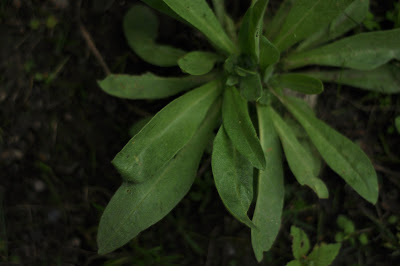 |
| second-year Woad flowering |
 |
| two-year-old Madder plants |
 |
| Yarrow |
 |
| self-sown Alkanet |
 |
| Weld |
 |
| Tansy |
 |
| Baptisia - False Indigo |
We've been growing some plants in a dyer's garden around the barn for the last few years; currently we have tansy, woad, weld, madder, yarrow, false indigo, alkanet, and golden marguerite under cultivation, and there is plenty of queen anne's lace and rudbeckia growing wild along the roadside nearby. I'll do a quick run-down of the colors these few plants yield up to yarn when used as dyestuffs.
Tansy (Tanacetum vulgare), which is toxic to all mammals if ingested, is a hardy perennial which will grow rampantly nearly anywhere. Its flowering tops make a great mustard yellow color on wool and silk with an alum mordant, and its leaves can dye from greyish green to dark green, depending on the mordant used.
Woad (Isatis tinctoria), is a self-sowing biennial plant whose first-year leaves can be used to make pale blue shades on wool. Older leaves produce darker blues, and mature leaves can dye a deep blue-black when used with madder. It is substantially less potent a dyestuff than indigo, but makes very lovely shades of reds, violets, purples, and green, when used with other dyes as a top or bottom. It makes a beautiful plant in a border, with lovely basal rosettes the first year, and then tall stalks topped with sprays of brilliant lime-yellow flowers the second year, that transform into handsome black seedheads.
Weld (Reseda lutea), is also a biennial that starts with a basal rosette the first year, and develops a tall spikey flower stalk the second year. It is the oldest known plant color fast form of yellow dye in the world, used primarily in Europe.
Madder (Rubia tinctoria), has been one of the most widely known and used dye plants since antiquity. The three-year-old roots are harvested, washed, and cut up. When ground finely with water and made into a decoction with baking soda, it creates an incredibly colorfast dye, ranging from red, purple, orange, yellow, and brown, depending on the mordant.
Yarrow (Achillea millefolium), is a vigorous perennial plant with aromatic gray-green foliage and yellow flowerheads. The flowers make a beautiful yellow dye when mordanting with alum, while the whole plant can create lovely rich olive tones when mordanting with iron.
False Indigo (Baptisia tinctoria - with yellow flowers, or Baptisia australis - with blue flowers), is a hardy perennial shrub that makes a very handsome garden plant for its beautiful foliage and pea-like flowers. It yields a pale blue dye, so cannot be considered any sort of substitute for true indigo.
Alkanet (Anchusa officianalis), is a self-sowing annual in our northern Vermont climate, and is a very pretty plant producing beautiful deep blue flowers mid-summer to frost. As its roots are the part used for dye, it's not a practical plant for us to cultivate for actual use because we can never collect enough mature root stock from a plant that dies back completely every year, but we like having it in the garden nevertheless. It is not considered one of the more lightfast dyes, but depending on the mordant can yield a range of color from grey-blue, to purple, to purple-black, to deep mauve.
Golden marguerite (Anthemis tinctoria), is a perennial plant in the aster family, also known as Dyer's Chamomile. It has a clumping growth habit and requires very little care, so is an easy option for the dye garden. The flowers will dye a yellow color with an alum mordant, and a deep golden hue with a chrome mordant.
Queen Anne's Lace (Daucus carota), is a prolific wild plant in our area, and its flowers yield some of the most electric and most subtle colors I have ever seen. With no mordant, it produces a delicate pale ivory color, but using alum, one can create truly vivid shades of chartreuse. It is reasonably colorfast and reliable.
Black-Eyed Susan (Rudbeckia hirta), is another wildflower growing along the dirt roads near the school. The whole plant used a dyestuff can yield a range of color from pale yellow, golden yellow, and olive green, mordants used being alum, chrome, and iron.
These are just a few of the vegetal dyestuffs we use in our summer dye workshops. Typically we will also include indigo, cutch, black walnut, saxon's blue and green, sumac, logwood, cochineal (when available), fustic, osage, brazilwood, iron buff, prussian blue, lac, bottle green silk, and some overdyes as time allows. So you can see, it is a really full weekend with multiple vats going all day long in succession. Each participant leaves with a beautiful swatch booklet with samples of all the work, including whatever yarn they bring to dye in the vats. Truly a wonderful experience, if I do say so myself.




































